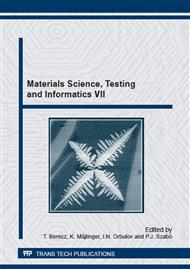p.131
p.137
p.143
p.149
p.155
p.161
p.167
p.173
p.181
Behaviour of AlMg3 Base Material and its Friction Stir Welded Joints under Cyclic Loading Conditions
Abstract:
The friction stir welding (FSW) is a dynamically developing version of the pressure welding processes. Nowadays, the knowing of the properties and the behaviour of the welded joints is an important direction of the investigations, especially under cyclic loading. The research work aimed (i) to demonstrate the behaviour of the FSW welded joints under cyclic loading conditions; (ii) to confirm the applicability of the used friction welding technology. Experiments were performed on 5754-H22 aluminium alloy and its welded joints; both high cycle fatigue (HCF) and fatigue crack propagation (FCG) tests were executed. HCF limit curves were determined based on staircase method. Statistical behaviour of the base material and the welded joints under FCG was represented by the cutting of the specimens, in other words by the using of different crack paths. FCG limit curves can be determined by own developed six step method. The investigations and their results were compared with each other and with the results can be found in the literature.
Info:
Periodical:
Pages:
155-160
Citation:
Online since:
February 2015
Authors:
Price:
Сopyright:
© 2015 Trans Tech Publications Ltd. All Rights Reserved
Share:
Citation:


